On The Town .. With Chip Deffaa .. Dec 12, 2014
As the year winds down, I’d like to use today’s column to look back on some productions or performances that, for one reason or another, have lodged themselves in my memory. They’re by no means equally strong, but they’re productions that have left an impact, and haven’t been discussed in this column before.
First. Terrence McNally’s It’s Only a Play (at the Gerald Schoenfeld Theater) has as strong an ensemble cast–and about as many laughs–as any comedy I’ve ever seen on Broadway. And I’ve seen innumerable shows. Theater has been my first love since my parents took me, when I was a kid, to see My Fair Lady during its original Broadway run.
Go and see It’s Only a Play, if you can get a ticket! It will be a long, long time before you witness any production on Broadway so perfectly cast. And I can’t imagine the play working nearly as well with cast-replacements.
The company includes: Nathan Lane (as a wonderfully over-the top, if insecure, star) and Matthew Broderick (as an earnest playwright)–you’ll get your money’s worth right there; those two pro’s can’t be beat for comedy on stage. They’re as good as we have, working in the theater today. And they work well together.
Stockard Channing (as an over-the-hill actress) is right up there with Broderick and Lane in this production, holding her own with them, line for line. She’s just as essential as they are to this play’s success. Megan Mullally and F. Murray Abraham and Rupert Grint add to the fun. And a wide-eyed newcomer named Micah Stock–remember that name!–is every bit as perfect in his characterization as the show’s six well-respected “name” co-stars, mentioned above, are in theirs. (I don’t know where director Jack O’Brien found this newcomer, Micah Stock; but for my money, his is the Broadway debut of the year. I really liked what he did with his part, playing the naive newcomer to the theater world.)
The script is filled with laughs. And, at its best, it rings true, as well. It captures the theater world I know. I’ve met and known people so very much like those depicted in this play. The second act of this play is not quite as strong as the first act, and occasional moments in the second act feel contrived. (Most of the show is so strong and so well-executed, I almost wanted to slap McNally–one of my favorite living playwrights–for settling for some lines late in the play that are not quite up to his standards.) But it is, on balance, terrific theater. And often surprising. I want to see this play again. Very well-written, very well-directed, very well-acted. That was my own personal favorite show of this year.
I’m going to talk now about some other shows I’ve enjoyed for one reason or another. I didn’t necessarily enjoy them as much as It’s Only a Play, but they all had elements that impressed me.
* * *
The most memorable cabaret show I’ve witnessed in the past year was that of Seth Sikes. He packed them in with his performances at the posh New York supper club 54 Below, offering a tribute to Judy Garland. The audience–filled with theater-world movers-and-shakers–was so enthusiastic, I’m sure the club will bring him back. He’s got a solid show that he could take present anywhere. He should take his show to nightclubs in Chicago, San Francisco, L.A. And perform on cruise ships, too. And record an album. But as enjoyable as the act is, I think Sikes has the potential–as a club and concert artist–to do bigger and bigger things. I’d like to see him reach greater heights. I’ll get to that–and explain more clearly what I mean– in a moment. But first, a little background on Seth Sikes.
His recent performances at 54 Below were his first public performances in about a decade. He’s been focusing, for the past decade, primarily on working behind the scenes, such as directing. In recent years he’s served, for example, as assistant director on such stage shows as Tribes and Pageant (Off-Broadway) and The Nance (on Broadway). But before this decade-long hiatus from performing, he impressed mightily those who saw him as a singing actor. He appeared in the off-Broadway musical Fame (singing, acting, and even playing a bit of trumpet, if memory serves, in the role of “Goody King”) at the Little Shubert Theater. He had a cabaret act, directed by Ryan Davis. And he appeared in a show of mine, Yankee Doodle Boy. All of that performing activity was a decade or so ago, and when he gave up performing (except for, perhaps, an occasional off-the-cuff number at a piano bar), everyone thought he’d given up performing for good.
He was moving up in the field of directing. (Assistant-directing a Broadway hit such as The Nance, starring Nathan Lane, was certainly a good credit.) Every individual must choose for himself (or herself) what career to pursue, and he’s found good work in the field of directing. But he was such an unusually good singing actor, I felt it was a loss to the theater world when he stopped performing. He and Dave Warren were the two singing actors of his age-group who I thought had the very best voices, and they both stopped performing around the same time.
I’m glad Seth Sikes is performing again. And he’s come back in a big way, with music-director Mark Hartman (who’s as good as it gets) leading a sassy seven-piece band that provides terrific support. Sikes, who’s now 30-ish, has as lovely a voice as any singer around town his age. His voice is strong, sure, and flexible, with an appealingly sunlit quality. And he understands “big singing”–a nearly lost art. He can carry off with aplomb numbers like “Rockabye Your Baby With a Dixie Melody” that most young cabaret singers would not know how to put across. And do it in such a convincing way that I did not want his rendition to end. He sings “Swanee,” too. And “Come Rain or Come Shine.” And an especially potent version of “The Man That Got Away.” These are tremendous songs, and his musical and vocal arrangements are based on those of his own favorite singer, Judy Garland. And Garland had sensational arrangements.
So when it’s time for Sikes to sing Harold Arlen and Ira Gershwin’s “The Man that Got Away”–as haunting a torch song as anyone has ever written–we hear the warm trombone easing him into the song, much as we heard the trombone do likewise when Garland sang the song in the film A Star is Born, or on her first studio recording of the song, or on her later famed “live” Carnegie Hall concert album. And when he gets into the tender heart of the song, the sax obligato shades the lyrics beautifully, just as it did for Garland. When he sings “Come Rain or Come Shine,” it is at the same breakneck tempo, paced by the bongoes, that Garland favored.
Sikes clearly loves these songs, and he “gets” them, and it is impossible not to share in his appreciation of them. And, I might add, he is no less interesting, when he is simply talking with the audience, speaking of growing up on a farm outside of Paris, Texas, and falling in love with Garland via her films The Wizard of Oz and Summer Stock,. And eventually making a pilgrimage to the last house she lived in. He has a very engaging presence on stage. He looks like he belongs there on that stage, singing these songs with unbridled zest. He holds back nothing. And I hope he will do more singing.
I enjoyed every minute of his act. It’s the best tribute to Garland I’ve ever seen. When he sings “You Made Me Love You”–and he sings it as well as anyone you are ever likely to hear sing it today–you can sense his love for Garland. Seth Sikes has made his return to performing in a very big way. And I am very happy about that.
The next step in his career… (and perhaps you’ve anticipated that there was a shoe about to drop) … will be to develop other acts, in addition to this tribute-type act which he is currently carrying off brilliantly. He needs to eventually be able to also offer sets consisting of songs he has picked with care, that he loves and relates to, that are not associated with any single artist like Garland, but simply songs he loves. Songs that he will sing in his own way.
Garland loved Al Jolson; like many people, she considered him the greatest of all entertainers. And that is why she chose to sing songs Jolson originally introduced and made famous (like “Rockabye Your Baby with a Dixie Melody” and “Swanee,” and “You Made Me Love You”); but she found her own way of interpreting them. Like Jolson, she could get inside those songs 100%.. But she did not follow Jolson’s arrangements; she found her own way of putting those songs across. What Seth Sikes is doing right now, he is doing phenomenally well. I’d enjoy seeing his tribute to Garland again any time. But I will also welcome, as he continues to do all he is capable of, him doing sets that are uniquely his own.
In the jazz world, I’ll often see a promising younger artist pay homage to his musical hero by re-creating, note-for-note, famous solos of his hero. And such homages can be thrilling to hear. But it’s also great to see the artists eventually find more of their own identity; it’s great to see artists eventually move out of their comfort zones, and take greater risks, putting their own artistic choices out there.
I love what Seth Sikes is doing right now. I also hope I get to see him, in time, bring that same gusto, and power, and verve, to songs he’s chosen, in arrangements uniquely his. He’s too talented not to eventually do that. His singing, in this show, knocked me out. But as he sang “Rockabye Your Baby,” in an arrangement modeled so closely on Garland’s, a part of me wanted to hear him use that arrangement as a foundation, as a springboard… to start by singing the song as Garland sang it, and then maybe sing another chorus or two, going more for himself, without worrying how anyone had ever sung the song before. And see if he could bring more of himself to it. He’s got it in him, I’m sure. His current act is great–and not to be missed. But it’s only, hopefully, the beginning. . I want him to be all he can be…. And now, on to some other, very different performances and productions I found memorable.
* * *
One realistic drama that held my interest this year from beginning to end was the Off-Broadway play Stalking the Bogeyman at New World Stages. It felt fresh; the characters felt authentic; and it had a certain urgency–as if the author and actors really cared, and were putting something extra into it–and I responded to that. It’s one of the few new plays I actually wanted to be longer; I wanted to know more about the two main characters.
Spanning the years 1978-2004, Stalking the Bogeyman is based on a true story, recounting one man’s murderous impulse to find and slay someone who’d raped him many years earlier. A grim topic, to be sure, but handled straightforwardly, and dramatized without comment, in a slice-of-life fashion that worked.
Journalist David Holthouse first told this story–about how he’d set out to kill a man who’d hurt him when he was a child, a quarter-century earlier–on a This American Life podcast. Writer/director/producer Markus Potter, who adapted this harrowing story for the stage, was driving in his car when he first heard Holthouse share his story; Potter was so stunned and shaken by what he’d heard, he had to pull his car off the road. He sought out Holthouse, obtained the rights to dramatize Hiolthouse’s story, and brought it to the stage. Potter was passionate about sharing this story, and it shows. We need more of that kind of passion in the theater.
Production values were excellent, and wise use was made of an attractive, highly detailed set by David Goldstein that served as different homes, in different times and places, as well as the office of an ineffectual therapist the protagonist wound up seeing.
The cast consisted of just six actors, but it felt like more due to some effective “doubling” of roles. (If I hadn’t consulted the Playbill, I doubt I’d have realized that the same actress was playing both the therapist and one of the mothers; they were thoroughly distinct characterizations.) Roderick Hill–anguished, taut, brittle, confused–was the protagonist; Erik Heger–by turns surprisingly menacing and childlike, threatening and playful–was the rapist. Both were presented as human beings, not as caricatures. And John Herrera impressed in three roles.
While I’ve seen other plays dealing with related themes, this one did a better job than most of making us feel what the protagonist was feeling. I liked the play, but at the end I also wished it could have been longer, offering us more fully-fleshed out portraits of the two main characters. I wanted to better know and understand both of them.
We got a very clear sense, for example, of David Holthouse-the-victim. But we are more than one things in our lives. It would have been more satisfying if we had gained a more complete understanding of the man. We felt his pain; but were not given a chance to really get to know him as anything other than a victim. Has he had satisfying relationships? Lovers? Is he straight or gay? Has he felt fulfilled in his personal life? In his work? How happy has he been, overall? We “get” the fact that he is quite troubled–and understandably so–over what happened to him more than a quarter-century ago. And it is understandable that that is the focus of the play. But I would have welcomed a chance to know that character more completely. And know his attacker more completely. (Neither individual is defined solely by events from a quarter-century ago.) I understand that this is a play dealing with actual people who are alive today, and privacy concerns might be a factor here. But dramatically, this good play would be better if we could understand more fully who these leading characters are, and what their lives are like. I think the play would be richer if we understood more completely these two men. At least, I wanted to know them better And have a more complete picture of their lives today.
All right. Now to discuss some lighter fare….
* * *
If a special award could be given for “Best Score Trapped in a Mediocre Show,” I would give it to the score of the musical Can-Can. The score, by Cole Porter–one of the greatest of all songwriters–is unusually rich. It includes “C’est Magnifique,” “It’s All Right with Me,” “I Love Paris,” and the irresistible title number (one of Porter’s wittiest “list songs”), “Can-Can.” These are first-rate Cole Porter songs–and Cole Porter is about as good as it gets, when we’re talking about songwriting. The show’s libretto (the “book”) by Abe Burrows, alas, is not especially involving. The critics, reviewing the original Broadway production in 1953, were, on the whole, rather tepid about the show itself, although they certainly recognized the genius of young Gwen Verdon, whose dancing was a highlight. That the original production of Can-Can lasted on Broadway for two years is at least partly because of the highly praised performance, in the original production, of the incomparable Verdon.
Due to the show’s book problems–and the perception that the show’s original success was due more to one stellar performer than to the material–the musical Can-Can is not often revived. When I’ve seen it revived (as I saw it revived a couple years ago, for example, at Westchester Broadway dinner theater), I find it a show that I want to love–if only because I love Porter’s music so much–but I cannot. There are moments of musical brilliance. But the show, in the book scenes, often seems to just lay there. (Cole Porter’s Anything Goes, by contrast, is much more fun, and hangs together better.)
This fall, Paper Mill Playhouse–the State Theater of New Jersey– presented a newly revamped version of Can-Can, with a script revised by Joel Fields and David Lee. I went to see this production with high hopes; maybe someone would finally be able to “fix” Can-Can, so it could live again. Maybe this new, revised version of this big old-school musical, directed by David Lee, would be strong enough to transfer to Broadway. Paper Mill has often done terrific revivals of older shows. And their shows are usually handsomely mounted. I had my hopes up….
I found the Cole Porter score to be every bit as wonderful as I remembered. Hearing those songs again was a treasure. And the company sure made the most out of the title song, performing it well twice. (I was in heaven, when they exuberantly performed that number again at the end; taking one extra chorus after another; Porter really was gifted, and that was the best part of the night.) This production also includes one song that was cut from the original production, “Who Said Gay Paree?,” that I liked a lot. So hearing some first-rate Cole Porter music in this revival was a high point of the year for me.
But alas, the newly revised libretto, like the old libretto, all too often just lays there. It is neither better than, nor worse than, the old libretto. I still did not care much about the characters. (And there sure seem to be a lot to keep track of!) The show, overall, felt oddly synthetic. And surprisingly bloodless. Un-sexy. (And this is a show that should be very sexy.) The show should have transported me to another time, another place… the demimonde of 1890s Paris. For the most part, I felt like I was watching a very hard-working cast laboring to put over a show that still does not quite work. I can’t imagine this production, in its current form, going any place. I wish I could report otherwise. There are some glorious, smart, witty, stylish songs in this show. (I did leave with Porter’s “I Love Paris” in my head.) But the production, overall, just didn’t do it for me. I would love to see Cole Porter have another hit on Broadway. But this production, in its current form, is not going to be it.
* * *
I enjoyed seeing Elf, which is currently playing (through January 4th, 2015) at Paper Mill Playhouse. The well-crafted libretto, by pro’s Thomas Meehan and Bob Martin (based on the film of the same name by David Berenbaum) is funny, and deftly written, and works for all ages. This is a fine holiday show for the whole family. Not a classic, by any means. But agreeable, and diverting, and heartwarming. The score, by Matthew Sklar and Chad Beguelin, is pleasant, rather than memorable (think “Broadway-lite”). But director Eric Ankrim, choreographer Josh Rhodes, and scenic designer Matthew Smucker have polished up everything nicely, and the production glows.
It is very well cast. James Moye is endearing as Buddy, the human who grew up among the elves at the North Pole, believing himself to be an elf. Robert Cuccioli is in peak form as his grumpy, overworked father, and Emily Blickenstaff and JakeFaragalli are equally believable (and likeable, and natural) as Buddy’s step-mother and step-brother. The production feels fresh. And if I did not exactly leave humming any of the songs, I left with a smile on my face. The show is not, by any means, a masterpiece. But Paper Mill has executed this production smartly. And it is nice to have a good new holiday show out there. There’s always a need for a good holiday show that you can take the whole family to. I’d be happy to take ‘em to this one…. Or maybe to a production of The Nutcracker.
* * *
I’m still elated from the production of The Nutcracker – by the Nutmeg Ballet Company, under the artistic direction of Victoria Mazzarelli – I saw this past weekend at the historic Warner Theater in Torrington, Connecticut. (The production photos by Susan Marine Suhanovsky show a couple of the company’s leading players, the superb Thel Moore and Alma Evertz, and others.)
The production moves next to the Bushnell Belding Theater in Hartford. I’d enjoy seeing it again. Associate Director Joan Kunsch told the audience, in welcoming them to the Warner Theater, that they were going to see some of the best young dancers in the world. And she’s right. But before I discuss the production itself, here’s a bit of historical background.
This year the Nutmeg Ballet Company celebrates its 45th anniversary. It’s received commendations and salutations from the City of Torrington, the Connecticut State Legislature, and the US Congress. When Executive Director Sharon Dante founded the Nutmeg Conservatory, her goal was to develop world-class artists. She’s succeeded; Nutmeg alumni have enjoyed careers in more than 60 different dance companies worldwide, including the New York City Ballet, the Boston Ballet, and the Joffrey, and have won their share of honors and accolades. And I’ve watched dancers I first saw as young up-and-coming artists with the Nutmeg Ballet Company go on to careers with assorted other troupes. My favorite Nutmeg dancers of recent years, Jack Sprance and Katherine Lamagdeleine, for example, are now dancing with the Boston Ballet (which is headed by another Nutmeg alumnus) and MOMIX, respectively. I’m sure the standout dancer in Nutmeg’s current troupe, Thel Moore–whom I’ve watched grow enormously as a dancer over the past few years–has a very bright future ahead of him.
Dante has also played an important part in transforming Torrington from a sleepy Connecticut town to an important regional cultural center. In the early 1980s, she and her dancers helped push to restore the Warner Theater–an abandoned, decaying 1931 movie palace (once hailed as “Connecticut’s most beautiful theater”)–that was then slated for demolition. They were part of a grass-roots citizens’ movement to save the venerable Warner Theater, so it could serve as a performing arts center. They achieved their goals. The very first “live” production at the revived Warner Theater, it’s worth remembering, was a ballet, “Copellia,” performed by the Nutmeg Ballet Company. Today, more than 30 years later, the magnificently restored Warner Theater is an entertainment destination for many, with a whopping 35,000 subscribers. Sharon Dante and her dance company helped make that possible.
Had Dante not founded the Nutmeg in Torrington, had the Warner Theater not been saved from the wrecker’s ball, Torrington would have been just another past-its-prime New England town. I love seeing any kind of entertainment at the Warner. (Foster Evans Reese’s production of Hairspray a few years ago was a particular delight.) And they offer a diverse array of attractions, from touring shows and bands and orchestras of all styles (the Glenn Miller Orchestra is playing there next), to their own theatrical productions. And I always enjoy seeing work by the Nutmeg dancers there. Now let me tell you about a performance I caught of The Nutcracker….
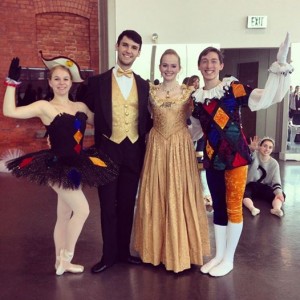
Sitting by me the other night, in the front row of the theater, were a mother and her four-year-old son, who–the mother told me–had never before seen a live performance of any kind. When the dry-ice mist began rolling off the stage towards us (the little boy was reaching out to touch it), with the “angels” moving onto the stage, the boy exclaimed simply, with awe, “Beautiful” (in his voice, it came out more like “Byooody-full”). When “the Cavalier,” Nicholas Gray–with a wonderful light in his eyes, and a smile as pure and joyous as that of the child watching him–went into his leaps and his turns, in the Grand Pas De Deux near the end of the program, the little boy exclaimed, “I want to dance.” That did it for me! At that moment–as Gray deftly executed his turns–I was applauding, as were many others in the house. But that four-year-old sitting by me saying simply, unselfconsciously “I want to dance,” was proof enough for me that The Nutcracker was working its magic. (And afterwards, that little boy tried to get a little girl sitting nearby to dance with him)
I want to say something more about the joie de vivre projected so vividly and notably by Gray in his best moments… and by Sarah Jimenez as “Dew Drop”; and by Andris Kundzins (isn’t that a great name for a dancer?); and by Kasey Arvold, “the Sugar Plum Fairy”; and by Emma Ziff, and by Julius Tauber, and by Jennifer Schwartz; and–oh!–I can’t forget newcomer Nick Keeperman (where does Nutmeg keep finding these impressive new dancers?), adding beauty and zest in his spots as both the “Snow King” and the “Russian Trepak Soloist”; and Isabel Jennings, imbuing the Arabian dance with such smoldering passion. These performers, and more–my apologies to those I’m forgetting–all seemed to delight in being on that stage. Audiences will forgive a lot of technical imperfections–and no one expects perfection from dancers who are early in their careers–so long as performers convey to them the joy of the dance. (As a director, I’ve often found myself telling that to performers working for me.)
I liked–with some reservations–NBC-TV’s recent “live” telecast of Peter Pan. (And I’ll say much more about that presentation in a bit.) But I liked the Nutmeg’s production of The Nutcracker more. Why? One reason was that dancers like Nicholas Gray and Sarah Jimenz and Nick Keeperman seemed to be enjoying themselves more on stage than Allison Williams was, playing “Peter Pan” on TV. Allison Williams is a decent singing actress, and she hit the correct musical notes. And, in many different ways, I liked the production; there’s a lot to like in that show. But Williams was so painfully earnest and noble, and did not seem to be having much fun. Even when singing “I’ve Gotta Crow,” she missed that merry, cocky, happy-go-lucky spirit that is essential to making the number fully land. Mary Martin was much more fun as “Peter Pan.” Martin had more of that boyish playfulness the role requires. And I have a hunch that if you ever gave Nicholas Gray or Nick Keeperman or Andris Kundzins a chance to play the role of “Peter Pan,” they’d project more joy, too. (Incidentally, I actually did see ballet-dancer Nicholas Gray in a production of Peter Pan once–not in the title role, but in the ensemble–when Peter Pan was done by the Milwaukee Ballet, and televised by PBS, back in April) Bur Gray, and Keeperman, and Kundzins just naturally radiated more happiness (and more confidence) while performing than Alison Williams did in Peter Pan. And that kind of spirit is more fun to be around.
I liked The Nutcracker a lot. And I have to give a special shout-out to German-born dancer Thomas Evertz, returning this year for, if memory serves me, about his tenth year as the spellbinding Dr. Drosselmeyer–a role he plays to dramatic perfection.
I did not want the production to end. So much beauty on that stage. And life. And potential. I like seeing dancers’ progress from year to year. It’s fun being in the presence of people who are doing–and doing well–what they were put on earth to do. And, oh! that glorious Tschaikovsky music. As the lights dimmed, towards the end of The Nutcracker, I was a little bit sad. I wanted to personally thank every member of that company. But I got home filled with energy. And when I got home, I might add, I found a message from a publisher, offering a contract to publish one of my recent plays. (It will be my 16th play to be published.) I think those dancers brought me good luck!
Every poised and graceful member of the company—not just the principal dancers–contributed to the overall effect. In ballet, every member of the ensemble counts. Even if, in a given performance, you are a snowflake (like, say, Kaliece Carter–and there’s another terrific name for a dancer), not a soloist, you can contribute–via delicacy and precision of movements–to the beauty of the scene…. The photos (by Susan Marine Suhanovsky), I think, capture well the feeling of the show.
* * *
I strongly believe that energy a performer gives off on stage is at least as important as his or technical skills. When I’m casting a show–and this year I had the pleasure of directing in New York productions of four different shows that I wrote–I pay more attention to the energy the actor gives off, and the presence he or she has, and the actor’s spirit than anything else. I don’t really care so much about what’s on the resume. I can gauge a lot–and get a good sense of the artist–just talking with him or her before the formal “audition” even begins.
This has been a wonderful year for me, as a playwright and director, because I’ve gotten to work with so many terrific performers, whom I very much like as people. It doesn’t get better than that. (And some of the actors, assistant directors, and choreographers I’ve worked with this year, who are now in their 20s, have worked with me, off and on, since they were young teens; I like that kind of loyalty, and I like seeing the individuals’ growth. I’m very grateful to be able to work time and again with actors, assistants, and choreographers like Rayna Hirt, Peter Charney, Emily Bordonaro, Tyler DuBoys. I’ve had great fun overseeing productions of my shows One Night with Fanny Brice, Irving Berlin’s America, Theater Boys, and The Irving Berlin Ragtime Revue. And the plays wind up getting produced all over. So I’m a very lucky guy. I enjoy writing plays, directing plays…. and writing columns like this.
As a director, I tend to give performers great latitude. I’d rather see what the performer creates than impose too much of my own choices on his or her performance. I don’t believe there’s only one correct way of interpreting a line, or creating a characterization; there are numerous ways that can work.
The only thing I’ll really ask of a star in a show of mine is: Be interesting.
* * *
And that brings me back to Peter Pan. Say what you will about Christopher Walken’s performance in NBC-TV’s Peter Pan, it was always interesting. His acting choices surprised me, and took a bit of getting used to. I’d always loved the big, broad, hammy-vaudevillian approach Cyril Ritchard brought to the role of Captain Hook, when he played opposite Mary Martin in the Peter Pan I so loved watching on TV as a child. (And if you’d have asked me, when I was six or seven or eight, what were the best things I’d ever seen on TV, I would have answered The Wizard of Oz and Peter Pan; they were, by far, my early-childhood favorites.)
I grew up believing Ritchard’s Captain Hook to be definitive. I still love what Ritchard did in the role. But I confess freely now–I love what Walken did portraying Hook, at least as much. Here was Walken, underplaying lines, throwing away lines, finding curious ways, in that oddly accented speech of his, to be at once deadpan and camp. His cadence is wonderfully idiosyncratic. His “Hook” seemed, at times, strangely introspective, in his own little world. But he was always interesting. Always a star. At age 71, some of Walken’s vitality is gone. But Walken at half-strength would still be more interesting than most players at full strength,
Amd when, with offhand grace, he led his pirates in that big tap-dance number, relatively early in the show, he had me. As soon as that number was finished, I was wishing I could see it again. He’s a unique talent. I think casting him was inspired. And for me, his presence alone made the broadcast worthwhile.
Kelli O’Hara was touching as Mrs. Darling; her moments, though brief, were first-rate. She shines. I also liked seeing the very enthusiastic, very acrobatic dancing of the Lost Boys. (If it reminded you a bit of Newsies when they danced, it’s because a number of them were in the Broadway show Newsies.) I think, ideally, the Lost Boys should be played by younger performers. (And you could certainly find some good younger performers–younger dancers from Nutmeg, the School of American Ballet, and other outfits could handle the work.) But, that said, their dancing really was terrific. I’m glad America got to see it.
Allison Williams was not a bad “Peter Pan.” She gave a plausible, and pleasant–if one-note–kind of performance. I wished they’d found someone who could have projected more of a sense of fun. (Christine DiTota, who played “Peter Pan” at Westchester Broadway Theater in 2010, actually did a much better job of conveying the elan of the character; when she sang “I’ve Gotta Crow,” there was joy in her voice, and a genuine pleasure in simply being alive, that I did not get from Williams. I’m not saying the Westchester production, overall, was better; it wasn’t. But she certainly captured the spirit of Pan better. I haven’t seen her acting lately; she’s been concentrating on directing–most recently staging “A Midsummer Night’s Dream” for the Armonk Players–but she was a splendid “Peter Pan.”) Christian Borle, whose work I ordinarily love (and have loved since I first saw him, as a young unknown, in Footloose), seemed oddly miscast as “Smee.” I’m glad to see him getting work (and becoming better-known to a wider TV audience), but he was used more wisely last year in NBC-TV’s The Sound of Music, on Broadway in Peter and the Starcatcher, and of course in NBC’s Smash.
The musical Peter Pan has plenty of surefire moments. I cannot imagine any child not being enchanted by the moment when Peter teaches the children to fly. I’m still enchanted by numbers like “I’m Flying” and “I Won’t Grow Up” (by Moose Charlap and Carolyn Leigh). And the show’s theme song “Never Never Land” (by Jule Styne, and Betty Comden & Adolph Green) remains perfect. “Captain Hook’s Waltz” (another Styne/Comden & Green contribution) is great fun, too. The story of “Peter Pan” has fascinated children since James Barrie’s book and play were brand new, more than a century ago.
I’m not sure the show really needed any new songs; I liked the show just fine the way it was. And it did not need to be made any longer. (The current version, including commercials, is three hours in length ) But the new songs fit in. And–to my happy surprise–the new song created to replace “Ugg-a-Wugg” turned out to be a real improvement on the original.
Concerning the new songs–credit must be given to Amanda Green (daughter of the show’s late co-lyricist Adolph Green, and a gifted lyricist in her own right); she wrote new lyrics to melodies written many years ago by the late Jules Styne, and she did so well. If you did not already know the show, you could not have guessed which songs were old, which were new. She worked with care and respect, and the show maintained a sense of unity.
This production lacked some of the humor of the original television version of Peter Pan. (I can still remember some gags from the original, that I liked as a boy, that I was sorry to see dropped now.) But I bet you the broadcast will prompt an increased interest in regional theaters and community theaters doing productions of Peter Pan. I’ll bet that Samuel French Inc. (which publishes and licenses the musical) will be seeing renewed interest in the title.
I look forward to seeing the broadcast again. I’m glad it attracted nine million viewers. Many young people, who might never have been exposed to much live theater, will become interested in musical theater via broadcasts like this. The show also provided employment for a lot of talented people in the New York theater community (including some friends of mine). I’m glad the whole country–not just Broadway audiences–gets to see, for example, how fine an artist Kelli O’Hara is. For many reasons, I’m all for these live broadcasts of musicals.
* * *
While we’re on the subject of interesting performers, can we chat a bit about Hedwig and the Angry Inch?
I’m gratified by the continuing success on Broadway of Hedwig and the Angry Inch. When this revival opened on Broadway, some industry wags said its popularity was due simply to the popularity of its star, Neil Patrick Harris. But they were wrong; the show has continued to thrive since Harris left it. This unique show itself is clearly reaching people, just as it did in its original Off-Broadway run. And the producers sure are making lots of money. With a company consisting of just two singing actors and a small band, running costs are modest, and profits are high. It’s a good show, and lots of fun. And I’ve been a believer in Hedwig and the Angry Inch from the start. I still have original cassette-tape “live” demo recordings, given to me by the show’s co-creator, John Cameron Mitchell, before anyone knew if the show would have a future. When Mitchell first started working on the project, virtually every industry pro told him the show was “not commercial,” and did not have a chance; I’m glad he never lost faith, and proved them wrong. I like that the show is drawing big audiences on Broadway.
To tell you the truth, though, I never thought Neil Patrick Harris was quite right for this role. He is very good in some roles; but for my tastes, he is too squeaky-clean, too boy-scout-ish, too mainstream to be an ideal “Hedwig.”
John Cameron Mitchell, who conceived the show, co-wrote it, and was its original star Off-Broadway, was a perfect “Hedwig”–edgy, offbeat, awkward, and charming all at once. I’m very glad he will be reclaiming the role he originated, in January.
It will be good to see him on Broadway for a couple of months, playing a part that fit him like a glove, back in the show’s original run. This show was Mitchell’s baby, and he gets it, and feels it, and owns it. He’ll be a more interesting – and unpredictable – “Hedwig” than I think Neil Patrick Harris ever was..
If the producers are looking for another terrific actor to play the role of “Hedwig,” after Mitchell leaves, I’d recommend Kevin Cahoon, who succeeded Mitchell in the original Off-Broadway run. Cahoon–just like Mitchell–has something wonderfully eccentric, and individualistic, and dark, and funny, and likeable abut him. He’s a great “Hedwig.” And can anyone really imagine Neil Patrick Harris leading a rough-edged rock band in his free time? Cahoon has actually done just that. I’ve always loved his work, whether on stage or leading his own rock band at a club like the late, lamented CBGB’s.
Hedwig is a terrific show, but it requires very careful casting for maximum impact. Kevin Cahoon is much better suited for the role of “Hedwig” than most who’ve played the part. And he’s endearing, and oddly vulnerable, in a way that Harris is not; but “Hedwig” should be. I hope the producers will cast him.
Sometimes producers get it right; sometimes they don’t. The worst “Hedwig” I ever saw was the grim, humorless Ally Sheedy, who played the show for a while, late in its original Off-Broadway run, and managed to miss many of the laughs. That was stunt casting at its worst. Someone no doubt thought she could sell tickets. (And I’d enjoyed her early film work.) But she couldn’t play the role.
* * *
Speaking of interesting performances, I was fascinated by Leslie Uggams’ performance in the Connecticut Repertory Theater’s production of Gypsy, which I caught this past summer at the University of Connecticut in Storrs, Connecticut.
I never thought I’d be writing that Leslie Uggams fascinated me in a performance. In her early TV work, Uggams never struck me as particularly interesting. To me, the young Leslie Uggams seemed pleasant and likeable–but also rather bland, innocuous–when she’d appear as a regular on television’s Sing Along with Mitch or, a bit later, on her own TV show. But she brought a lifetime of experience to her performance as Mama Rose in Gypsy, and she got inside that role, and–oh boy!–she worked it. I’ve seen her a number of times on Broadway. I’ve noted her growth, over the years, in shows ranging from Jerry’s Gilrs, to King Hedley, to On Golden Pond. But still, this performance was a revelation. I’ve gained much greater respect for her as an actress, having seen her command the stage in Gypsy.
She was often, in her performance, quiet and dignified–not qualities we’d normally associate with Mama Rose. But she gradually revealed a fierceness that was formidable. She was genteel. (I normally think of Mama Rose as being rougher around the edges, and more obviously tough.) But she was also a woman of intense determination, a woman you felt would do anything to make a star of her daughter. Anything. And there she was–by turns “proper” and respectable, and sweet, and yet with a ruthless edge revealing itself. This is one of the most challenging of all roles in musical theater. And she rose to the challenge.

She is not the ideal Mama Rose; the role is written for a more bravura approach. When you hear Ethel Merman’s original cast recording, you are hearing the role the way the show’s creators envisioned it. But in her own way, Leslie Uggams gave us a highly memorable and highly credible Mama Rose. I’ve seen Gypsy many times; it is one of my all-time favorite shows. And “Mama Rose” is a very tough role to carry off. Over the years, I’ve seen some very good performers fall short of the mark, attempting this role. But Uggams held my attention from start to finish. And now I’d go see her in anything.

Incidentally, she is believed to be the first African-American performer ever to play this role. Race seemed totally irrelevant. She caught us up in the character quickly. Kudos to Uggams, and to director/choreographer Cassie Abate. There were others in the cast who made the most of their moments as well, from Michael James Leslie as Rose’s father, to Steven Hayes as Uncle Jocko, and the whole production moved nicely. But I watched everything Uggams did with great interest.
* * *
And while we’re on the subject of Gypsy, I want to share some high praise for Merman’s work, by one of the most respected actors of his time (and one who was not easily impressed by musical-theater work)–John Gielgud. In one of Gielgud’s letters (which have been collected and published), he wrote (August 11th, 1959): “Gypsy was quite fun, Merman really superb, a sort of musical-comedy Edith [Evans], relentlessly powerful, tragic, funny and certain, with incredible selectivity and confidence in every word she speaks or sings.” You can’t ask for greater praise than that.
My own favorite Mama Rose, of all I’ve ever seen play the role, was Betty Buckley (at Paper Mill Playhouse). Her singing and acting were both superb, and she found an ideal mix of power and vulnerability. I liked very much both Bernadette Peters and Patti LuPone, in their Broadway revivals, but found Peters a little too soft and cuddly for the role, and LuPone a little too unrelentingly hard Still, they were unforgettable Mama Rose’s. Uggams acted the role very effectively, showing a steely strength all the more surprising because she seems, at first,. So unimposing a woman. I’ve seen other respected actors playing “Mama Rose,” such as Linda Lavin, for example, fail to convey that strength.
* * *
I greatly appreciated Goodpeed Opera House’s production of Fiddler the Roof – with Adam Heller (whom I always enjoy on stage) as a very natural, believable, down-to-earth Tevye. Directed by Rob Ruggiero, with choreography modeled on the original choreography of Jerome Robbins, the show worked. It remains one of the best-constructed musicals around. And if you simply trust the material, it never fails to go over. One of the daughters seemed miscast; there was no ethnic flavor to her speaking or singing. But that show is so powerful, I feel almost churlish complaining about one actress’s limitations.
I am sorry that Michael Price, who has headed Goodspeed almost since its establishment in the 1960s, is departing. He’s had a terrific track record.
I’ve seen Fiddler a lot of times. The actor friend I took had never seen it, on stage or on screen. A reminder to me that there is always a need to revive these classic works.
***
As I look back on the year just ending, I want to note one dance program that came as a special treat. I enjoyed seeing the debut performance of choreographer Brian Simerson’s new dance troupe, “Simerson & Company.” This imaginative, inventive choreographer has done good work for others, such as MOMIX. It’s about time–long overdue, if you ask me–that’s he’s forming a company of his own.
I was delighted to see in his hand-picked troupe some dancers whose work I’ve long appreciated elsewhere (such as Ben Youngstone) and one dancer (Cameron Clark) who’d left the field for some years and has happily returned (he is a natural, so it is good to see him dancing again). And I’m glad Simerson got to take his dancers to the Jacob’s Pillow festival. Hope to see more of Simerson & Company.
* * *
In the past year, Trumbull (CT) High School attracted national press attention after the administration tried to cancel a scheduled production of Rent; students lobbied long and hard to get that decision reversed; they won their campaign, and I greatly enjoyed going up to see their production, sitting with the family of the late Jonathan Larson, who wrote Rent. I was glad to be invited back to the school again recently–this time to see their latest student production, Arthur Miller’s 1953 drama The Crucible. I like that the school’s theater program (under the guidance of Jessica Spillane) is not shying away from doing challenging material. Kudos to student Matt Buckwald (who impressed mightily playing the role of “Angel” when the school did Rent); he directed this production. (It’s admirable that the school lets students direct productions; not all schools do that, but it’s the best way for a student to learn.) I was also glad to see the incredible support the community gives student theatrical productions; it’s amazing to see a huge auditorium packed once again, with young people and parents alike–just as it was for Rent–for a thoughtful, serious period drama like The Crucible.
This is not an easy play for young performers to do (or for young audiences to take in), but the students carried it off well. It’s set in the time of the Salem witch trials, and we see innocent adults sentenced to death because of the callous accusations of young girls that they were in league with Satan. Arthur Miller wrote this cautionary drama during the hysteria of Senator Joe McCarthy’s witchhunts, when accusations that people might be Communists could ruin lives.
Dylan Shepard and Katherine Griffin were sympathetic leads. And Colin McLevy was right on target as the stern, self-righteous (yet somehow likeable, nonetheless) Deputy-Governor Danforth, determined to root out evil. Miller always writes so that we see the humanity of all characters, be they villains or heroes; that’s one of his strengths. And McLevy got the nuances just right, portraying with compelling conviction a man who believes himself to be doing good–to be doing, in fact, God’s work–while he’s sending innocent people to their deaths. And the girls making the accusations were frightfully believable.
* * *
I must register one small complaint, though: the program for the play failed to mention Arthur Miller’s name anywhere; he was not credited, although he created this enduringly popular, widely produced e play. I’m sure that’s just an accident. But I have to say something, because I see this sort of oversight–forgetting to credit the playwright–all too often when I attend school or community-theater productions. It is essential for the playwright be credited. (It is also a contractual obligation, part of the agreement one makes in obtaining permission to perform a play.)
Arthur Miller (1915-2005) was one of the greatest of all American playwrights. (There’s certainly no writer I enjoy more.) He wrote more than 30 plays for the stage, as well as assorted radio plays, film scripts,. and other works, including such unforgettable plays as Death of a Salesman, All My Sons, and The Price. . He’s an American cultural treasure. (I wish I could says he’s been revered everywhere. But when I was young, Russia banned his works.) Making audience members aware of Arthur Miller should be part of the school’s mission, too. Especially at a school running as strong a theater program as Trumbull’s. But I’m proud of the Connecticut youths doing justice to this play.
– CHIP DEFFAA, December 12th, 2014


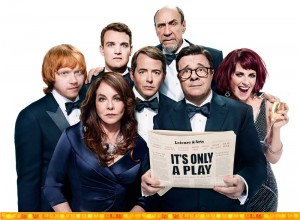

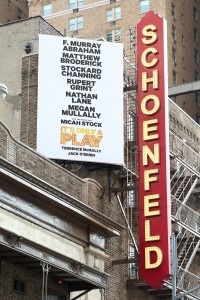




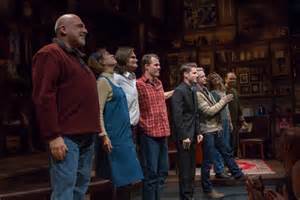
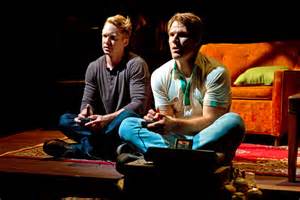


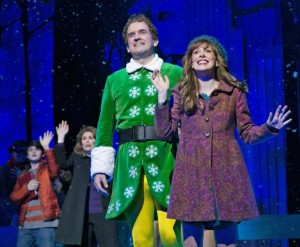
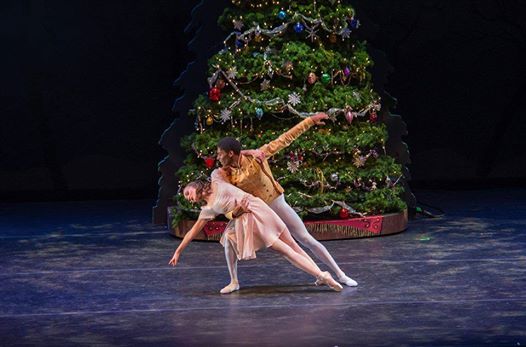











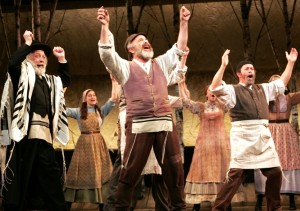
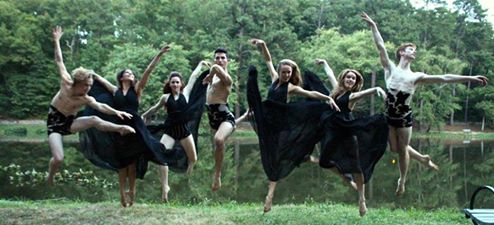
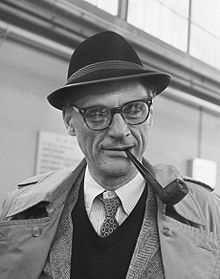





Leave a comment